![]() A note to my english speaking visitors: This website only serves to give you an idea about my german book Codierte Kunst (Coded Art).
A note to my english speaking visitors: This website only serves to give you an idea about my german book Codierte Kunst (Coded Art).
about the Book | Preface & Introduction | How to order the Book
CODIERTE KUNST – Kunst Programmieren mit Snap!
CODED ART – Programming Art with Snap!
Preface
- The idea and the motivation for this book: combining computer art & programming
- No systematic programming course, but „learning exactly what is needed to solve a problem“
- General aim: To build up an „aesthetic laboratory“ (according to Nees)
- Tracing early computer art, that is doing computer art yourself
- Implementation of concrete art and other art genres
Introduction
- Trigger I: 50 years of computer art
- Trigger II: 50 years programming language Logo and Paperts constructionism
- Chapter Overview
Computerkunst
- What is computer art, „artificial art“
- Introduction based on image examples and features:
 Example 1: Nake Line Hatching
Example 1: Nake Line Hatching- Example 2: Lecci Shift 2
- Example 3: Noll Sinusoide
- Example 4: Nees axis-parallel aberration
- Example 5: Noll vertical-horizontal
- Example 6: Franke Squares
- Example 7: Molnar Structure of squares
- Basic elements of computer art
- Algorithmic Art
- From the plotter to the drawing robot
Recoding and Remixing
- From reprogramming (through image analysis, design and structure, necessary program components) to variations and further developing
- Graphic elements and programming concepts
What is Snap!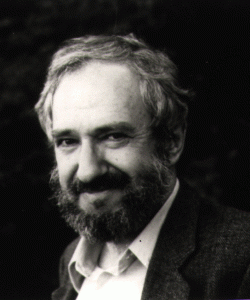
- VVisual programming
- The beginnings of Logo
- Papert’s constructionist approach
- Constructionism and Visual Programming
We start Snap!
- Call in the browser
- Components of the programming environment
- Orientation on the stage
Getting started in Snap!

- Before we start with real pictures we need a few basics:
- Construction and handling of the system
- Direct mode
- One after the other …
- Repetition (Homage à Steller: Rhythms)
- Modularization and extensibility
- Generalization (
- Homage à Vilder: Variations on 9 Squares)
- Control Structures (
- Homage à Riley: Movement in Squares)
Impossible? That’s impossible!
- Language extensions of Snap! through own program extensions
- own collection: Pi, exponentiation etc.

- Random numbers made by yourself
- Tools, modules, costumes, sounds
Everything is nice and colorful here …
- Color models (RGB, HSV)
- Homage à Mihich: Painting #207
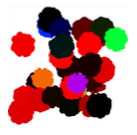 All by chance … the simulated intuition
All by chance … the simulated intuition
- Painting by blots …
- Random numbers in Snap!
The figure building kit
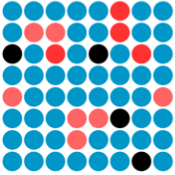
- Basic elements of computer art
- Points
- Homage à Hugonin: Binary Rhythm
- Homage à Müller: 64/6
- Homage à Struycken: Komputerstrukturen
- Homage à Molnar: 96 Punkte
- Lines and straight lines
- Homage à Sol LeWitt: Bands of Color
- Polygons

- Homage à Noll: Gaussian QuadraticRhythm
- Curved lines
- Homage à Nees: Arcs
- Areas
- Homage à Molnar: 25 Squares
Hommage à Laposky: From the analog to the digital
- Laposky – Precursor of computer art

- Recoding Lissajous
- Remixing Lissajous (I): Sinus-Cosinus-Additions
- Remixing Lissajous (II): Attachments
Homage à Marcus & Co.: Pattern from figures
 Patterns of repetitive, area-covering structures
Patterns of repetitive, area-covering structures- Homage à Aaron Marcus: Urbane Nova
- Homage à Komura: Optical Effect of Inequality
- Homage à Bartnig: 256 …
- Homage à Mohr: Scratch Code
- Excursos: Stamping instead of painting
- Homage à Sýkora: Black and white structure
- Homage à Coqart: Structured Squares
- Excursos: Procedures as data
Homage à Nees: Gravel
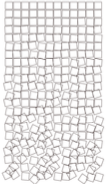 Recoding & Remixing one of the most famous images of early computer art
Recoding & Remixing one of the most famous images of early computer art- Code comparison: Nees gravel
- Recoding I: iterative
- Recoding II: recursively; reprogramming
- Remixing Gravel: shapes and colors
A block is a block is a block …
- An insert about recursion with
- Excursus: local vs. global variable

Homage à Kolomyjec: Boxes
- An early recoding of Gravel
Homage à Nees: The language G
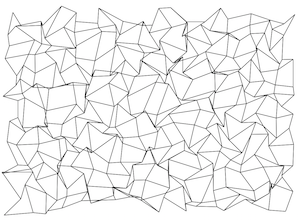 A reference to the problem-oriented language G for the generative graphics, which is embedded in the support language ALGOL 60
A reference to the problem-oriented language G for the generative graphics, which is embedded in the support language ALGOL 60- Excursus: Arrays and Lists in Snap!
- Recoding Disturbed tissues
Homage à Nake: Simple graphics
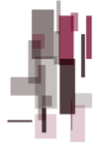 A chapter on his attempts to bring certain vectors to paper
A chapter on his attempts to bring certain vectors to paper- Rectangle crosshatching
- Labyrinth
- Droves of straight lines
Homage à Noll: Stile studies
 Recoding Noll, Remixing Riley: Sinusoide
Recoding Noll, Remixing Riley: Sinusoide- Recoding Noll, Remixing Mondrian: Composition With Lines
Homage à Molnar: disorders
- Recoding & Remixing: One percent disorder

- Recoding & Remixing: (dis)orders
Homage à Schneeberger: SNE KAO
- Reiner Schneebergers graphics system SNE COMP ART, with which he wants to open „an immediately practical access to computer graphics and especially to computer art“
- Recoding and Remixing of SNE KAO

Homage à Sýkora: Painting lines
- Recoding and Remixing of Lines
Everything in motion
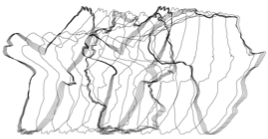 Remixing also involves putting computer art in motion
Remixing also involves putting computer art in motion- Color installation: painting … wiping … painting
- Excursos: Working with objects (I) -Sprites
- Remixing Schotter (II) – Clones
- Homage à CTG: Return to Square
- Homage à Csuri: Hummingbird
- Homage à Resch: Network structures
Kinetic Art
 Central element is the impression of movement, by the movement of the observer, an optical illusion or the self-movement of the object
Central element is the impression of movement, by the movement of the observer, an optical illusion or the self-movement of the object- Homage à Gerhard von Graevenitz: 5 black rectangles on white
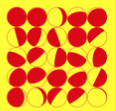 Homage à van Weeghel: Dynamic Structures
Homage à van Weeghel: Dynamic Structures- Excursos: Coupled objects
- Homage à Talman: k25
Even more computer art …
- Another 18 selected examples of prominent representatives of early computer art and other art genres
- ASCII-Art: Texts as graphics
- Homage à Barbadillo: Arch images
- Homage à Bartnik: Square development
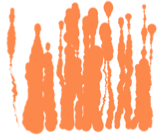 Homage à Beckmann: DONKO Generator
Homage à Beckmann: DONKO Generator- Homage à Beyls: Grid Based Systems
- Homage à Csuri & Schaffer: Feeding Time
- Homage à CTG: Random Windows
- Homage à Franke: Squares and circles
- Homage à Gruppo N: Dynamic Visions
- Homage à Korneder: Centers
- Homage à Land & Cohen: : Flowers
- Homage à Nash: Triangle 9
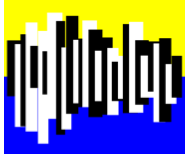 Homage à Roubaud: Circular segments
Homage à Roubaud: Circular segments- Homage à Schott: Zerkiemung
- Homage à Sonderegger: Butterfly
- Homage à Steller: Tectonics
- Homage à Strand u.a.: Turning areas
- Homage à von Graevenitz: Great horizontal distribution
Moiré-Pattern
 In der OP-Art, geometrical abstraction and optical illusions were used by pattern-like repetitions, which are shifted against each other in different planes
In der OP-Art, geometrical abstraction and optical illusions were used by pattern-like repetitions, which are shifted against each other in different planes- Homage à Besemer: Swoop Wave Bulge
- Homage à Devecchi: URMNT
Programming Art ?!
 The generation and output of the images by means of the computer can also be applied to other art forms
The generation and output of the images by means of the computer can also be applied to other art forms- Homage à Josef Albers: Interaction of Color
- Homage à Morellet: Random principle
- A little excursos: Painting with mouse and finger
- Homage à Jackson Pollock: Drip Painting
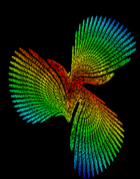 Think out of the box
Think out of the box
- Mathematics and Art
- Biology, mathematics and art
- Evolutionary Art
- Painting machines and painting robots
- Software tools for art production
- Excursos: Live-Coding with Snap!
Conclusion and outlook
- Media Art: Interaction & Multimedia & Networking
Literature & Picture Credits
Appendix A:
- Tips and Tricks for Snap!
- Help and making work easier in Snap!
- Save and load
- Further sources of information
Appendix B: The Command Blocks of Snap!
Appendix C: Block library
Index

